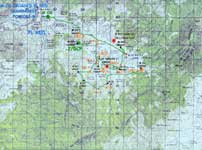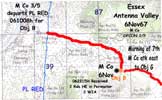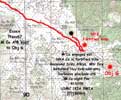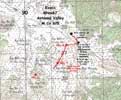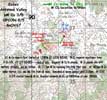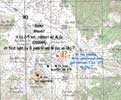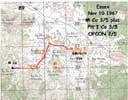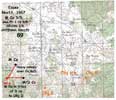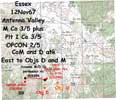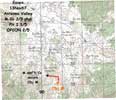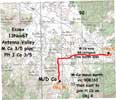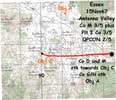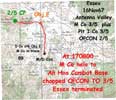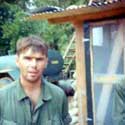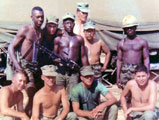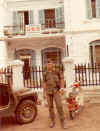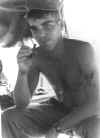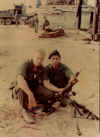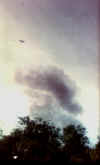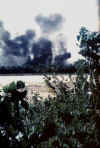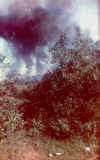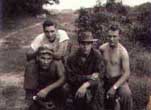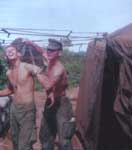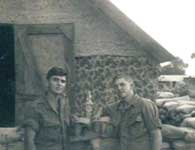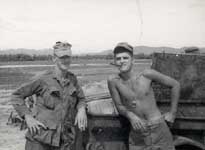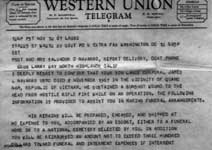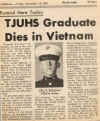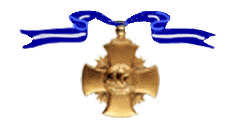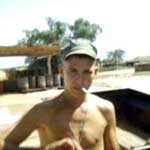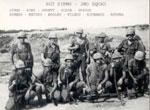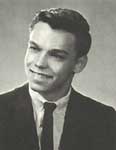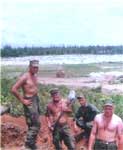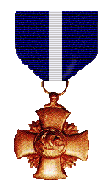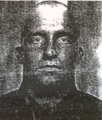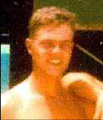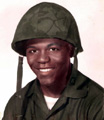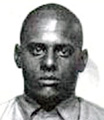[Home][Table
of Contents][What's
New][Picture
Gallery][USMC Picture
Pages ]
Operation ESSEX This
is NOT an official USMC combat operations page, but our personal attempt
to recover as much information as we can about the operations the 3rd
Battalion, 5th Marines M Co. participated on in Vietnam. Operation
ESSEX 6-17 November 1967 2nd
Battalion, 5th Marines Combat After Action Report
The above map of Antenna Valley and the day-by-day maps below were prepared by JD Murray using the Operation ESSEX Combat After Action Report (AAR) and info from M/3/5 Marines who were there. Based on requests by numerous M Co. Marines who participated on Operation ESSEX, I have developed a daily set of maps of M Co. movements for that operation. Since I was not on the operation, I have incorporated the 2/5 After Action Report (AAR) and eye witness accounts that include Marines of M Co. CP, and a Marine who was near where the boobytrapped bomb exploded.These maps are an ATTEMPT, some 35 years later, to depict the movement of M Co. during the entire operation, and in particular, the confusing hours of the ambush during the 8/9Nov67 time frame. In my opinion, AARs only reflect one side of the story. Example--At 1707pm M Co. erronrously reports his unit location vicinity 905362 which indicates he was on Obj. X. It was later determined that his true position was vicinity 909366. By my plotting, M Co. WAS in vicinity of Obj. X because he was in the ville portion of Obj. X. Obj. X is very large!! If he gave his coors. as 905362 he was probably off by a couple of hundred meters. If he said he was in the vicinity of Obj. X, he certainly WAS!! We do not have the transmissions that occurred between M Co. and the Bn. The TRUE LOCATION of M Co. as indicated by the AAR was probably the rear elements of M Co. that remained there when the ambush (8Nov67) occurred. This location was probably called in by H Co. 2/5 in the early hours of 9Nov67 when they finally reached the rear elements Of M Co. near the far stream from the ville.~JD The morning of the 8th says a lot about the early movement of the company at 080300 am to the attack position, first attacking Obj. A, then moving on to attacking Obj. T, and finally moving on to Obj. X. This is a company that was in a heavy firefight in the late afternoon of the 7th, up by probably 2 a.m. to move out by 3 a.m., attack two Objs. by noon, and proceed on to Obj. X in the late afternoon. That's a rough day to then be faced with the ambush set on them on the afternoon of the 8th. JD *************************************************
The night the NVA ambushed us on ESSEX, Capt. Fretwell, Mike Callahan, myself and about fifteen other guys got caught on the trail below the village we were trying to take. Mike was carrying the company radio, and crawled up next to me trying to get to Capt. Fretwell. As he did, he was killed by the machine gun fire that was raking the trail. If he hadn't of been next to me I feel certain I would have got it. Mike was a great kid, and will always be in my heart. That same night within minutes after Mike got hit, the NVA rolled a Chi-Com grenade down from the village above us which landed on my back, and the Marine behind me knocked it off into the rice paddy below us. I would sure like to know who he was and thank him again for that. That night on the trail on ESSEX was the worst night of my life. They were shooting at us from directly above, rolling hand grenades down on us, dropping mortars next to us, and raking the trail with machine gun fire (that's what got Mike). The guy that knocked the grenade off of my back survived, Capt. Fretwell survived, and one other fellow up the trail. The FAC got it, our corpsman got it (I'm hoping we can get his name out of the Nov. 67 Unit Diary)...he was only fifteen feet or so from Mike and I. After I had done everything I could (I called in artillery on every trail out of the village towards the mountains), I crawled along the trail checking for wounded and whispering my name as I went. I was feeling for warmth, but everyone was cold except one guy, and as I got close he rolled over to show me the .45 he had under his chest... he said it was a good thing I was whispering my name because I almost got my head blown off. Received a Purple Heart from a Chi-Com grenade...shrapnel in my arms, and the worst piece about 1/4" above one of my eyes.~Steve Cottrell
Mike Co. walked into a horseshoe ambush on Operation ESSEX. They let us walk just far enough in, then closed in us, opening up on us from all sides, including machine guns low and high. Can't remember the names of the guys we lost that day, there were so many. I still see their faces every day and every night. We lost a lot of good Marines on ESSEX. ********************************
I am Antonio Martinez, known to those in my squad as Shortround or Littlebit, as my squad leader Cpl. Brooks nicknamed me. I first entered the Marine Corps in Feb. 1967 and after basic training, a short leave home, and having had my orders changed from going to radio school back to advanced infantry training, then two weeks of scout sniper school, I found myself in the RVN sometime in the middle of August of 1967. I was assigned to Mike Co. 2nd platoon, Sgt. Peters' 2nd squad. My first major operation was Operation SWIFT. As with other Vietnam veterans, the thirty years plus dulls the sequence of events, but I do know this: the day Operation ESSEX began for Mike Company, I remember humping into Antenna Valley. We started out before daybreak, I recall, along a narrow winding dirt road. This road climbed up the moutain and then down into the valley. I remember having to pass close to a Vietnamese farmer leading a huge water buffalo, I remember thinking how huge this animal as, and I was a little frightened that as I passed him he might not take too kindly to me passing as close to him as I had to because of how marrow the road was. We descended into the valley during the course of the day. We were accompanied by some type of tracked armored vehicle, I can't remember what they were called. Around midday or so, I remember sitting on top of this vehicle and watching our fighter jets pass over us and beyond on their way to provide close air support for the lead element. I remember seeing huge explosions that seasoned Marines said were B52 strikes. I was in awe, I remember thinking it looked almost like small atom bombs. You could feel the sound of the explosion. Also, someone made the statement that they thought the USS New Jersy's 16-inch guns were in support. We could hear the shells as they zoomed over us. It was for lack of better description, awesome. Word filtered back to us that the lead element in the operation had been caught in an open rice paddy as they attempted to negotiate a fence. From a treeline it was said a .50 caliber machine gun opened up on them, and they took heavy casualties. What we understood to be our objective in this operation was to push the NVA to the otherside of the valley and an Army unit, which I've come to find out was an Americal Division, was to be a blocking force. It was our understanding that this Army unit was on the other side of the mountains at the end of the valley. That night Mike Co. sat in with the armored vehicles, if I recall correctly. I was fire team leader then in Cpl. Brooks' squad and with me in my team were two FNGs, one by the name of Jimmy Robertson (we had an altercation later that night resulting in a broken nose for which I was to be medevaced, but wasn't). That night in our hole, we had incoming, what I believe was artillery...I don't know if it was ours or theirs. The night Mike Co. was hit hard, I remember Cpl. Brooks and the squad were not the lead squad in the company. We started taking sporadic fire from the direction of a village. As we approached the village, we were getting reports that the NVA were being spotted to our rear. There was a paddy lying between our unit and the village. The company comander began to position our company in that rice paddy. The plan was to conduct a frontal assault on the village while conducting an envelopement manuever to the left of the village with what I believe to be a couple of squads from our platoon. Evening was approaching, we were shielded from the village by a huge dike almost as tall as me and I am 5'5". To our rear was a creek and lining our side of the creek was a thin line of bamboo. On the other side of the creek the bank was layered in three stairstep like tiers. As the company crowded into the rice paddy, I remember feeling uneasy about so many of us crammed into that rice paddy. As we begn to deploy to the left of the village, we started to take incoming mortar rounds. We were sitting ducks. Explosions started to go off everywhere in the rice paddy. We were pinned down. From my vantage point, I could see this happening. I was at the edge of a creek that was to my rear. In the confusion of explosions, and the cries of wounded Marines someone yelled, "Fall back across the creek." No one moved at this time, and I remember Lt. Blacksmith or Becksmith (He was a very husky built Marine who had played football in college, so they say), I remember him saying, "Yeah, get back across the creek." We hesitated, and I with much hesitation suddenly jumped down in the creek and crossed it, and began to negotiate each tier. The going was hard because the banks were muddy and footing was slippery. All the while I could hear explosions and small weapons fire. I reached the top tier only to meet a thick wall of bamboo. I tried to crash through the wall of bamboo, and it was as if I just bounced back from it with each attempt. I was able to work my way through the daylight, and suddenly from the trees above us I could see a stream of green tracers coming down on us. There was mass confusion. Our assault never materialized. As I freed myself from the bamboo, I broke through the other side into an open rice paddy. Other Marines also broke free into the rice paddy. We were essentially cut off from the rest of our unit. We learned later that our unit was scattered. We stayed in that rice paddy for the night without incident. During the night our scattered unit and our wounded were infiltrated by the NVA. They killed many of our wounded where they lay, except the next day we learned that one of our corpsmen was discovered by the NVA, the story goes that the NVA noticed his corpsman insignia on his collar and instead of killing him they took his .45 pistol and shot him in the foot, and covered him up with backpacks that were strewn across the battlefield. The next morning the company regrouped and gathered our dead and wounded. It was the next morning that we discovered that in the creek were many KIA. What had happened was a machine gun emplacement up the creek, and the gooks in the trees opened up on the second wave of Marines that tried to cross the creek. They allowed the first wave to cross so we would think it was safe to cross. In that creek is where Cpl. Geibe was killed. I remember him because he used to walk point for a rival squad of Cpl. Brooks. Cpl. Brooks and Geibe's squad leader used to brag that they had the best pointman. That morning our battalion commander came out to relieve our company commander of his command. I remember this well because I was still tagged because of my nose, and Doc told me to go over and stand with the people who were going to be medivaced. I was flown to a field hospital soon after. Some of the other things I recall is about a 2nd Lt. that was killed in a firefight, it was said he had been directing his men and took a round through his armpit and entered his heart. The thing I remember most about that was that they could not fly him out, and we had to carry his body throught the night until the next morning, I believe. I remember because I was one of the ones that had to carry him. I remember thinking how heavy a dead body was. I also remember there was a corporal, I didn't know him, and I don't even know what he looked like. The day he was KIA I recall hearing an explosion as well as seeing the dust fly. Four or five Marines were also wounded. As my squad moved up to where the explosion took place, I remember seeing the wounded lying on the ground and a corpsman whose name I can't remember was administering aid. This was also the same corpsman that took care of me when I was wounded in December. He was a short, chunky, little black corpsman. A strange thing happened then, somehow someone upset a hornet's nest. They were flying all around, suddenly Doc jumped up swatting at the hornets and started to run. All the Marines that were lying on the ground also got up and started to move out. We joked about it later. The Marine who was killed was said to have sat on a booby trap shell. And at the time I believe, he was carrying an M79 grenade launcher with bandoliers of grenades strung on him. He didn't have a chance. For some distance away from the explosion as we moved out, we found bits of clothing. I remember Doc passing by me with a plastic bag in his hand and in it was a tag. I asked, "What you got there, Doc?" He replied, "It's Kretsinger."
*********************************************
2nd platoon was the point platoon when we got online to assault the village. I was with the point squad. I got shot in the knee and was medivaced. When I returned to the company, they sent me back to 1st Force Recon where I stayed till Sept. 1968 when I got my third heart. Semper fi. *********************************
Bill Little was killed 7, Nov. '67 on Operation ESSEX. Myself, Steve Walker-(Haygood now) and Roger Nicholson were wounded as well as Little, and a brown bar Lt. who was our platoon commander and had been incountry just 9 days. The platoon commander was killed instantly in the ambush. Little, Nicholson, and I were medi-vac'd to BAS (Battalion Aid Station). I was treated and given last rites, but I told the Chaplain to give Little rites because I saw him get hit, and he had a bad sucking chest wound. He was hit, and then a few seconds later I got hit. I was put on a chopper, and we waited about 20 minutes with the chopper just idling. After about 15-20 minutes, the door gunner tapped me on the shoulder, pointed to the BAS tent, and gave me a "thumbs down." We then took off for Da Nang with only me on the chopper. I found Little's sister about 12-13 yrs ago, and called her. She was very curious about how he died, and coincidentally, it was his 22nd Birthday when he got killed. In the summer of '68, I bumped into a guy named Ralph Ashura (sp?). We were in the same rocket team one time, and he was literally behind me when I got hit. He told me about the big Battalion-sized, U-shaped ambush that the NVA had sprung on Mike Co., and that it turned into a running, all day battle. He told me that Donald Kretsinger and David Jones ("Jonesie") both died on the next day. Nov. 8, I heard that Kretsinger stepped on a booby-trapped 105mm arty shell. Maybe Jonsey, but I think it was Kretsinger. I was told also that Pete Schrader (he was my best friend, we joined Mike Co. at the same time) got caught when our line was advancing and then had to pull back, but he got caught (he was radio operator) in the open and didn't make it back. Asura told me that on the morning of the 9th of November that he helped carry Pete's body, and that the gooks apparently used his body for a marking target, and had "probably 150 rounds in him." I was told this by Asura just a few days before he was to be discharged. We bumped into each other near the Mainside Flag Pole at Camp LeJeune about June or July of 1968. Semper
Fi
******************************
Bill Little, Don Kretsinger and another guy named Jones were all from Illinois, and they were all killed during Operation ESSEX. They had a dollar bill torn into 3 pieces, and each had a piece. I remember Bill talking about how they were going to put it back together when they got back to the World, and have a beer to celebrate living through that nightmare. I believe they all went through boot camp together, and ended up in Mike Company. If memory serves me, they were all killed in a short time span. Kretsinger was killed the next day when he stepped on a booby-trapped bomb, I am not sure about Jones, I believe he was shot. After we were bushwacked and the wounded were loaded on the chopper to BAS (Battalion Aid Station), a second lieutenant, don't remember his name, was also KIA at that time, and they forgot to put his body on the chopper and had to carry it with them. The next day, the company was ambushed again, and they took a lot of casualties. I watched the corpsman giving Little mouth- to- mouth resuscitation all the way in to BAS trying his best to keep him alive, it was a tough thing to watch. I was on the next bed while the doctors worked on Little trying to save him, but they couldn't. The corpsman who was working on him (can't remember his name) stayed at the aid station while the docs worked on him. I can remember the corpsman broke down and cried when Little died, we both took it very hard. It is a hard thing to go through watching your pals die like that. I can still see him laying there after 35 years. Steve Walker was on the chopper also, he was hit at the same time, I believe he was hit in the leg also. He must have went on to another hospital, lost track of him after that, until I found him on the "Mike " website along with some other guys I served with. ******************************** India
Co. 3/5 (submitted by Curtis Eidson, I/3/5)
1. We
were so close we could see the bombs falling before they hit. We ducked
because we knew the power of the things hitting.
************************************************************** 3rd Battalion, 5th Marines Killed In Action on Operation ESSEX 7 November 1967
LCPL.
JAMES LEE NAVARRO CPL.
RICHARD WINERFRED DUNCAN, M Co. 3/5 PFC.
MICHAEL JOHN CALLAHAN, M Co. 3/5 PVT.
DARREL EUGENE PRUETT, M Co. 3/5 CPL.
DAVID LEE JONES, M Co. 3/5 9 November 1967 CPL.
PETER ANTHONY SCHRADER, M Co. 3/5 CPL.
RICHARD JOHN GIEBE, M Co. /3/5 PFC.
MAX RALPH IDOM, M Co. 3/5 ******************************************************************** Increased September activity in I Corps once more caused General Westmoreland to send reinforcements north. On 4 October, Colonel James D. McKenna's 3rd Brigade, 1st U.S. Cavalry Division, having been transferred to III MAF and, in turn, to the Americal Division, began Operation Wallowa in the Que Son Basin. With the arrival of this brigade, the Americal Division took over responsibility for the entire basin and the 5th Marines moved to Hoi An, relieving Colonel Ing's 1st Marines there. Operational control of the 1st Marines shifted from the 1st to 3rd Marine Division and Colonel Ing then moved his headquarters and two battalions to the northern provinces of I Corps. Most operations in southern I Corps during the last three months of 1967 reflected the enemy's desire to avoid casualties, but even in this the enemy was unsuccessful. The Americal Division, now commanded by Major General Samuel W. Koster, USA, continued to harrie the 2d NVA Division in the Que Son Valley as the Communists frantically tried to collect rice and supplies there. During October, the Army units, engaged in Operation Wheeler and Wallowa, were in almost constant contact with small NVA units. by the end of the month Operation Wheeler had reported 498 enemy killed, while Wallowa recorded another 675 NVA dead. During November, the Americal Division combined Operations Wheeler and Wallowa as Operation Wheeler/Wallowa and a force of seven U.S. Army battalions, more than twice the number previously available, deployed in the area. The army battalions systematically pursued NVA elements as they tried to escape to the mountains in the west. Ancillary operations such as the 2d Battalion, 5th Marines' Essex in "Antenna Valley," six miles south of An Hoa, drove the enemy back against the Army units in the basin. There were two main engagements with NVA forces in Antenna Valley during Operation Essex. Both involved company-sized attacks on fortified villages which the North Vietnamese chose to defend. Lieutenant Colonel George C. McNaughton, commander of the 2d Battalion, 5th Marines, described these fortified villages in his after-action report: "In each instance, the village had a wire fence around the perimeter...consisting of three to six strands of cattle fence with woven wire running up and down through the horizontal strands. The wire fence line was either concealed in bamboo tree lines or camouflaged with bamboo and shrubs. Behind these perimeter fences, the enemy had dug a communication trench...that was four to six feet deep with firing positions and deep caves for protection against artillery and air attack. Some of these caves were fifteen feet deep. Spider holes, caves, and bunkers were found in depth through the village. Fortifications were carefully located to achieve an interlocking and mutually supporting series of defensive positions. Both (villages) were located such that attacking infantry had to cross stream barriers (to reach) the defensive positions. As attacking troops emerged from the stream beds, they found themselves to be within close range (50-150 meters) of the enemy perimeter defenses with open rice paddy in between. (Both villages were) situated on the sides of the valley adjacent to high ground such that the enemy had ready routes of egress into the mountains." Both Marine attacks took place during afternoon hours and the enemy force successfully defended its positions into the night. In each case, however, the NVA defenders withdrew from the fortified positions under cover of darkness in spite of continuous artillery fire in and behind the village. "In summary," wrote McNaughton, "when Marine units attacked the villages in the afternoon, the enemy defended with vigor. When Marine units delayed an attack until dawn and conducted heavy preparation by air and artillery, the NVA units made their escape." Company H, commanded by Captain Gene W. Bowers, conducted one of the fortified village assaults. Bowers used tactics similar to those that had succeeded so well in a similar situation during Operation SWIFT. Company H had landed by helicopter in Antenna Valley earlier in the day, as had the rest of the 2d Battalion, 5th Marines. The company then proceeded toward its assigned objective, the village of Ap Bon (2) in the northeast portion of the valley. As it approached the objective, Company H made heavy contact with a large enemy force within the village. Captain Bowers ordered Second Lieutenant Duane V. Sherin to maneuver his 2d Platoon to the left of the village and then envelop the enemy. The platoon, however, ran into more NVA soldiers in the heavy brush west of the village, sustained two Marines killed and several wounded, and then, on Bowers' orders, withdrew with its casualties back to the company. Upon its arrival at the company position, Bowers directed the 2d Platoon to move to the company's right flank and establish a base of fire for an assault on the village by the 1st and 3rd Platoons. The assault began after air and artillery strikes on Ap Bon (2). Bowers recalled the subsequent action:
The fighting developed into an exchange of rifle fire and grenades as reported air strikes hit the village. Some bombs and napalm fell within 50 meters of the exposed Marines in the paddies. Captain Bowers requested reinforcements and Captain Edward J. "Buck" Byer, Jr.'s Company F arrived about 1600. With Company H acting as a base of fire on the village, Company F made an assault which the North Vietnamese repulsed. At dusk, both companies moved back about 70 meters, carrying all wounded Marines and equipment, and established night defensive positions. The North Vietnamese maintained pressure on the two companies until almost dawn despite flares and machine gun fire from AC-130s, which fired on targets within 10 meters of the Marines. Around 0430, the North Vietnamese slipped away. At dawn, the two Marine companies advanced and searched the village without resistance. There were no enemy bodies. All bunkers and trenches had collapsed under the intensive artillery and air strikes. The Marine companies had suffered 53 serious casualties, including16 dead, in the fighting of Ap Bon (2). The following days involved pursuit of small groups of fleeing NVA soldiers. On 10 November, the 2d Battalion captured an NVA aspirant (officer cadet) who claimed to have been in Ap Bon (2) on 6 November. He said the village had contained a division headquarters battalion. A direct bomb hit on the command post bunker killed the battalion commander; 60 enlisted men died in the fighting and many were severely wounded. Operation Essex ended a few days later on the 17th. *********************************************** My name is John L. Tucke, and I am a retired USMC Captain [1964-1986]. During Operation Essex, I was assigned to Golf Company, 2nd Bn, 5th Marines as an enlisted Platoon Weapons Commander. My M-60 gun teams were already attached to the rifle platoons. On 6 November 1967, we were part of a large-scale operation to "search & destroy." Sometime late in the morning of that fateful day [beautiful clear skies], we received word that one of our companies had been ambushed by the enemy [unknown which company]. For the next several hours, we humped over all kinds of tough terrain - trying to get to the ambushed Marines. Unfortunately, we walked in the same path as our predecessors and were also pinned down. The firefight was heavy and at the close of day, we were forced to pull the remnants of two USMC rifle companies into a tight perimeter. Throughout the night, the enemy raked our positions with automatic weapons and we were unable to reach those Marines who had been killed or wounded earlier in the day [one platoon+.] Although some attempted rescue, generally we were confined to our chosen perimeter. In the morning, my Company Commander appointed me to find an evacuation site. By that time, major fighting had ended and we were able find a suitable landing zone. Once the zone had been secured, helicopters flew in and evacuated both the dead and wounded. I have a vague idea of how many we lost over the previous 24 hours, but the numbers had to approximate at least 100+dead and wounded. Operation Essex would be my last major operation. Less than one month later, I would lose one Marine to a self-inflicted gunshoot wound and one depressed squad to one booby trap [12/4/1967]. I rotated during January 1968, and just missed the great Tet offensive in which Golf Company 2/5 would fight for Hue City. In 1969, I returned for my second tour in Vietnam; this time as a patrol team leader for Alpha Company, 3rd Recon Battalion, 3rd Marine Division. After all these years, I still remember Operation Essex more than any other and those Marines who gave their lives. I am so sorry!~John L Tucke, Capt. USMC/Ret ***********************************************************
LCPL.
ALFRED EARL ANDERSON, Hotel Co. 2/5
*******************************
|



















